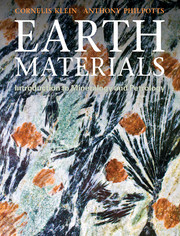Book contents
- Frontmatter
- Contents
- Preface
- Acknowledgments
- Chapter 1 Introduction
- Chapter 2 Materials of the solid Earth
- Chapter 3 How are minerals identified?
- Chapter 4 Fundamentals of crystal structures
- Chapter 5 Introduction to crystallography
- Chapter 6 Minerals and rocks observed under the polarizing optical microscope
- Chapter 7 Igneous rock-forming minerals
- Chapter 8 How do igneous rocks form?
- Chapter 9 Igneous rocks
- Chapter 10 Sedimentary rock-forming minerals and materials
- Chapter 11 Formation, transport, and lithification of sediment
- Chapter 12 Sedimentary rock classification, occurrence, and plate tectonic significance
- Chapter 13 Metamorphic rock-forming minerals
- Chapter 14 Metamorphic rocks
- Chapter 15 Some economic minerals, mainly from veins and pegmatites
- Chapter 16 Some selected Earth materials resources
- Chapter 17 Earth materials and human health
- Glossary
- Minerals and varieties
- Common igneous, sedimentary, and metamorphic rocks
- Index
- References
Chapter 16 - Some selected Earth materials resources
- Frontmatter
- Contents
- Preface
- Acknowledgments
- Chapter 1 Introduction
- Chapter 2 Materials of the solid Earth
- Chapter 3 How are minerals identified?
- Chapter 4 Fundamentals of crystal structures
- Chapter 5 Introduction to crystallography
- Chapter 6 Minerals and rocks observed under the polarizing optical microscope
- Chapter 7 Igneous rock-forming minerals
- Chapter 8 How do igneous rocks form?
- Chapter 9 Igneous rocks
- Chapter 10 Sedimentary rock-forming minerals and materials
- Chapter 11 Formation, transport, and lithification of sediment
- Chapter 12 Sedimentary rock classification, occurrence, and plate tectonic significance
- Chapter 13 Metamorphic rock-forming minerals
- Chapter 14 Metamorphic rocks
- Chapter 15 Some economic minerals, mainly from veins and pegmatites
- Chapter 16 Some selected Earth materials resources
- Chapter 17 Earth materials and human health
- Glossary
- Minerals and varieties
- Common igneous, sedimentary, and metamorphic rocks
- Index
- References
Summary
In this chapter, we provide short discussions of some selected major Earth material resources that are used in our everyday existence.
The construction industry is the biggest user by far of sand and gravel, together with cement, dimension stone, and common clay. Sand and gravel is mined in every country in the world.
Steel is a major component in high-rise construction, ships, cars, bridges, appliances, and armaments. Energy supplies cannot be effective without pipelines, furnaces, and engines, which are usually made of steel. The original source of the iron used in steel making is found in iron-ore deposits, which are the iron-enriched products of sedimentary iron-formations. Iron deposits occur in most countries but large to very large iron deposits are restricted in number.
Clay minerals are hydrous aluminum silicates with layered structures that occur with a grain size of <2 µm in the largest dimension. Kaolinite (Sec. 10.4), Al2Si2O5(OH)4, is a primary constituent of kaolin. Another clay mineral, montmorillonite, with the approximate formula of (Na,Ca)0.3(Al,Mg)2Si4O10(OH)2•nH2O, is the dominant clay mineral of bentonite, a major constituent of volcanic ash. This material has many technical applications. Vermiculite with an idealized formula of Mg3(Si,Al)4O10(OH)2· 4.5H2O[Mg]0.35 is another clay used in various commercial applications.
- Type
- Chapter
- Information
- Earth MaterialsIntroduction to Mineralogy and Petrology, pp. 450 - 467Publisher: Cambridge University PressPrint publication year: 2012



